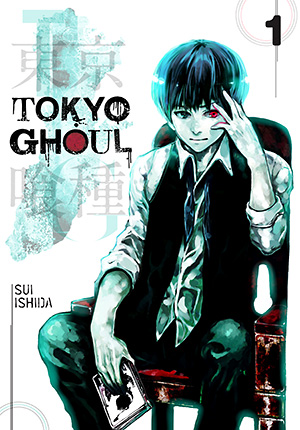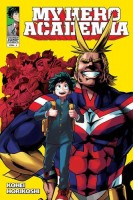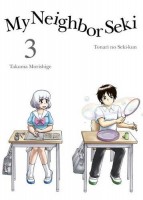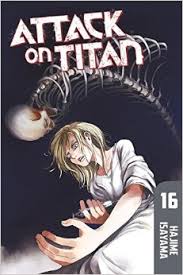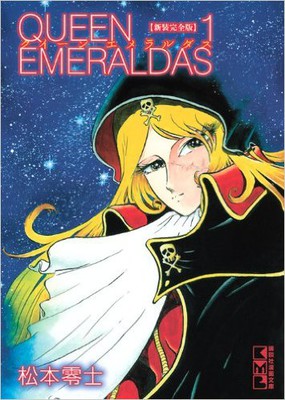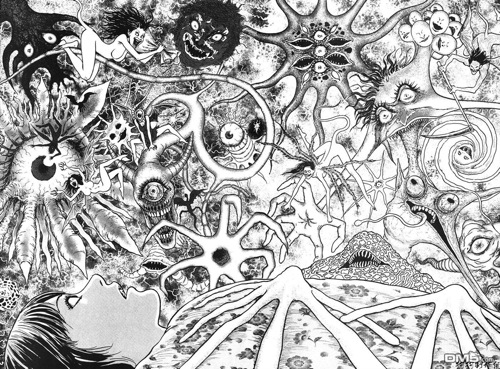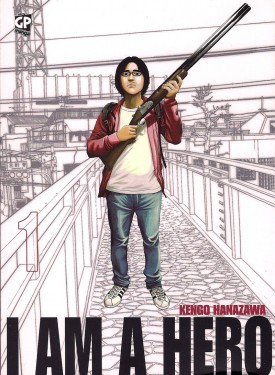Ultraman made his television debut in 1966, defending Earth from the dual scourge of aliens and giant monsters. What began as a 39-episode series soon blossomed into one of Japan’s most prolific franchises, yielding dozens of sequels, spin-offs, movies, video games–and now a manga, which has been running in Monthly Hero’s magazine since 2011. Today’s column looks at this incarnation of the Ultraman story, which arrived in stores on Tuesday.
For extra insight into Ultraman‘s history, I encourage you to check out Brigid Alverson’s interview with Tomohiro Shimoguchi and Eiichi Shimizu, the creators of the latest Ultraman manga.
 Ultraman, Vol. 1
Ultraman, Vol. 1
By Eiichi Shimizu and Tomohiro Shimoguchi
Rated T, for teens
VIZ Media, $8.99 (digital edition)
Dusting off a beloved franchise and making it appeal to a new generation is a hazardous undertaking: stray too far from the source material and incur the wrath of purists, but hew too closely to the original and risk camp. Manga-ka Eiichi Shimizu and Tomohiro Shimoguchi have found an elegant strategy for introducing Ultraman to contemporary readers, using the original premise of the 1966 TV show as a starting point for a new chapter in the story.
The prelude to volume one neatly outlines Ultraman’s origins. Shin Hayata, member of the Science Special Search Party (a.k.a. the Science Patrol), unwittingly becomes the host for Ultraman, a powerful alien tasked with ridding Earth of dangerous monsters. Only a few members of the Science Patrol know Ultraman’s true identity–a secret they keep from Hayata, who is unaware that he is the vessel for Ultraman’s powers. The story then leaps forward thirty years: Ultraman has returned to his own world, Hayata has retired from the Science Patrol, and his son Shinjiro is beginning to manifest powers of his own.
In contrast to the introduction, which is a model of economy, the first chapter sags under the weight of too much expository dialogue. The characters relate their histories and concerns in such bald declarations that the entire chapter reads like a rejected Mystery Science Theater 3000 script. (A sample exchange: “We certainly don’t see much of each other these days.” “Right, even though I work at the Ministry of Defense, too.”) The pace improves with the sudden appearance of Be Mular–one of Ultraman’s old adversaries–who lures the inexperienced Shinjiro into a rooftop battle. Although the script has a familiar rhythm–powerful attacks punctuated by snappy one-liners–the fight choreography is well executed; you can almost feel the force of Shinjiro’s punches. Equally important, the fight’s outcome is not a foregone conclusion: the chapter ends on a cliffhanger just as Shinjiro realizes that he isn’t strong enough to protect his family from Be Mular… yet.
If the 2.0 version of Ultraman sounds like a radical departure from the original series, rest assured that Shimizu and Shimoguchi haven’t strayed too far from the show’s roots. The proof lies in the character designs: they’ve done a nice job of bringing Ultraman and Be Mular’s appearance in line with contemporary seinen aesthetics while preserving the look and feel of the original characters. Ultraman and Be Mular don’t exactly resemble their rubber-suited predecessors, but a long-time fan will recognize them as spiritual descendants–a fair compromise for a series that’s toeing the line between 1960s kitsch and 2010s pop culture.
The verdict: The first chapter is a tough slog, but the combat is staged with enough panache that I’ll be checking out volume two.
Review copy provided by VIZ Media.
Reviews: Here at Manga Bookshelf, Sean Gaffney and Michelle Smith tackle the latest volumes of Black Rose Alice, Citrus, Evergreen, and Food Wars! Further afield, Megan R. takes a nostalgic look at Kare Kano: His and Her Circumstances; Aimee A. deconstructs shojo stereotypes in Skip Beat!!; Seth Hahne praises Ajin: Demi-Human for its “fantastic cat-and-mouse” plotting; and Erica Friedman reviews Manga de Tsuzuru Yurina Hibi, a “non-fiction comic essay” about the relationship between a businesswoman and her girlfriend.
Alice Vernon on Akame ga Kill! (Girls Like Comics)
Wolfen Moondaugter on vol. 22 of Arata: The Legend (Sequential Tart)
Austin Lanari on The Art of Satoshi Kon (Comic Bastards)
Sean Gaffney on vol. 5 of Assassination Classroom (A Case Suitable for Treatment)
Nick Smith on Awkward (ICv2)
Emma Weiler on vols. 1-5 of Crimson Spell (No Flying No Tights)
Lesley Aeschliman on vol. 10 of Deadman Wonderland (WatchPlayRead)
Lori Henderson on vol. 1 of The Demon Prince of Momochi House (Manga Xanadu)
Frank Inglese on vols. 5-6 of Food Wars! Shokugeki no Soma (Snap30)
Sheena McNeill on vol. 7 of Food Wars! Shokugeki no Soma (Sequential Tart)
Johanna Draper Carlson on vol. 10 of Happy Marriage?! (Comics Worth Reading)
Rebecca Silverman on vol. 1 of Haven’t You Heard? I’m Sakamoto (Anime News Network)
Erica Friedman on vol. 2 of Hayate x Blade (Okazu)
Allen Kesinger on vols. 4-5 of High School DxD (No Flying No Tights)
Matthew Alexander on vol. 6 of Judge (The Fandom Post)
Sarah on vol. 2 of Karneval (Anime UK News)
Anna N. on vol. 5 of Kiss of the Rose Princess (The Manga Report)
Austin Lanari on The Kurosagi Corpse Delivery Service Omnibus Edition: Book One (Comic Bastards)
Ian Wolf on vols. 1-2 of Maid-Sama! (Anime UK News)
Kristin on Manga Classics: Emma (Comic Attack)
Ken H. on vol. 1 of My Hero Academia (Sequential Ink)
Ash Brown on The Science of Attack on Titan (Experiments in Manga)
Frank Inglese on vol. 1 of Tokyo Ghoul (Snap30)
Michael Burns on vol. 1 of Tokyo Ghoul (Ani-TAY)
Michael Burns on vol. 2 of Tokyo Ghoul (Ani-TAY)
Julie on vol. 2 of Tokyo Ghoul (Manga Maniac Cafe)
Lesley Aeschliman on vol. 1 of Ultraman (WatchPlayRead)
Elizabeth Lotto on vol. 1 of Ultraman (The Outer Haven)
Nick Lyons on vol. 1 of Ultraman (DVD Corner)
Rebecca Silverman on vol. 9 of What Did You Eat Yesterday? (Anime News Network)
Wolfen Moondaugter on vol. 2 of The World’s Greatest First Love: The Case of Ritsu Onodera (Sequential Tart)

